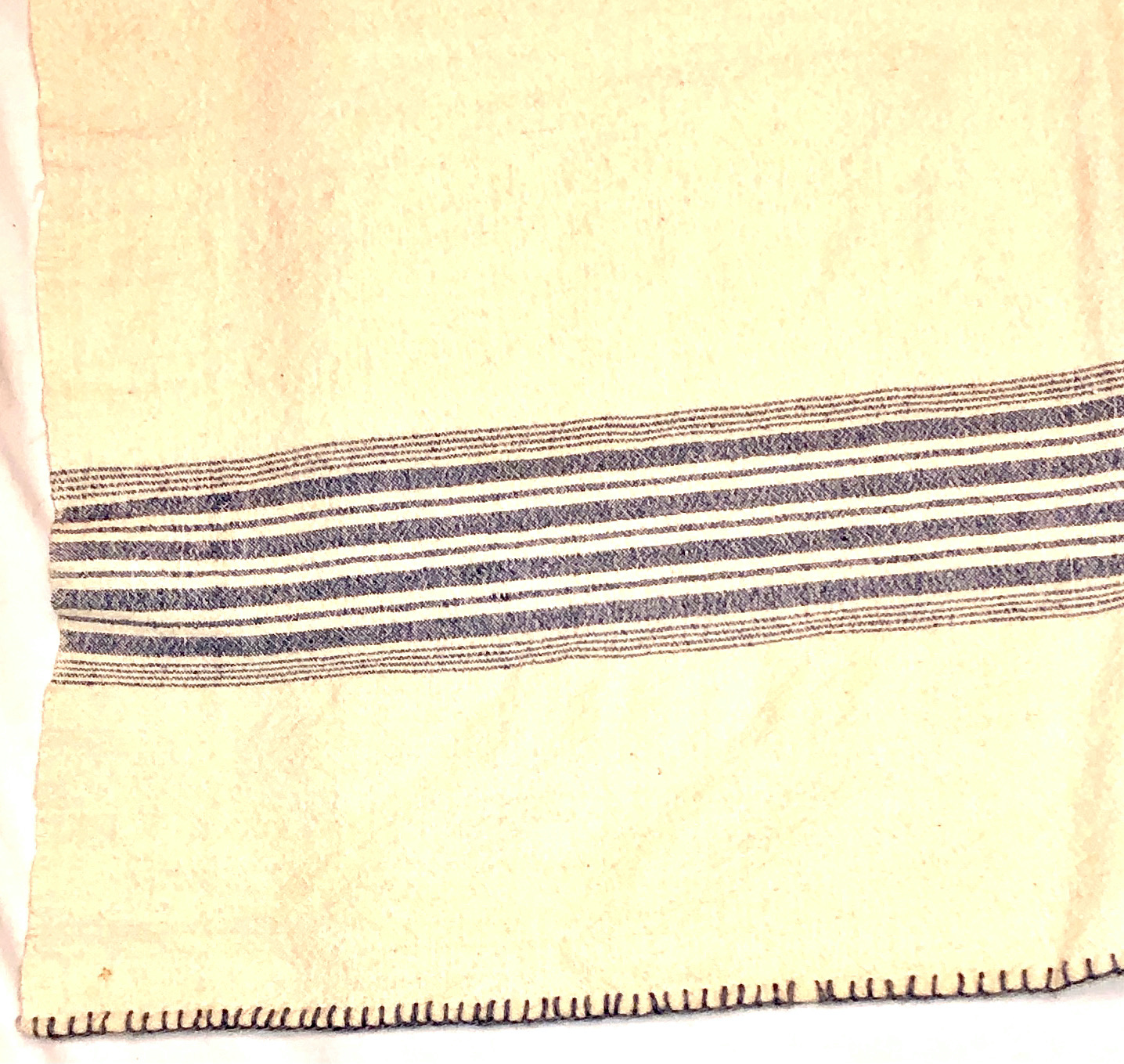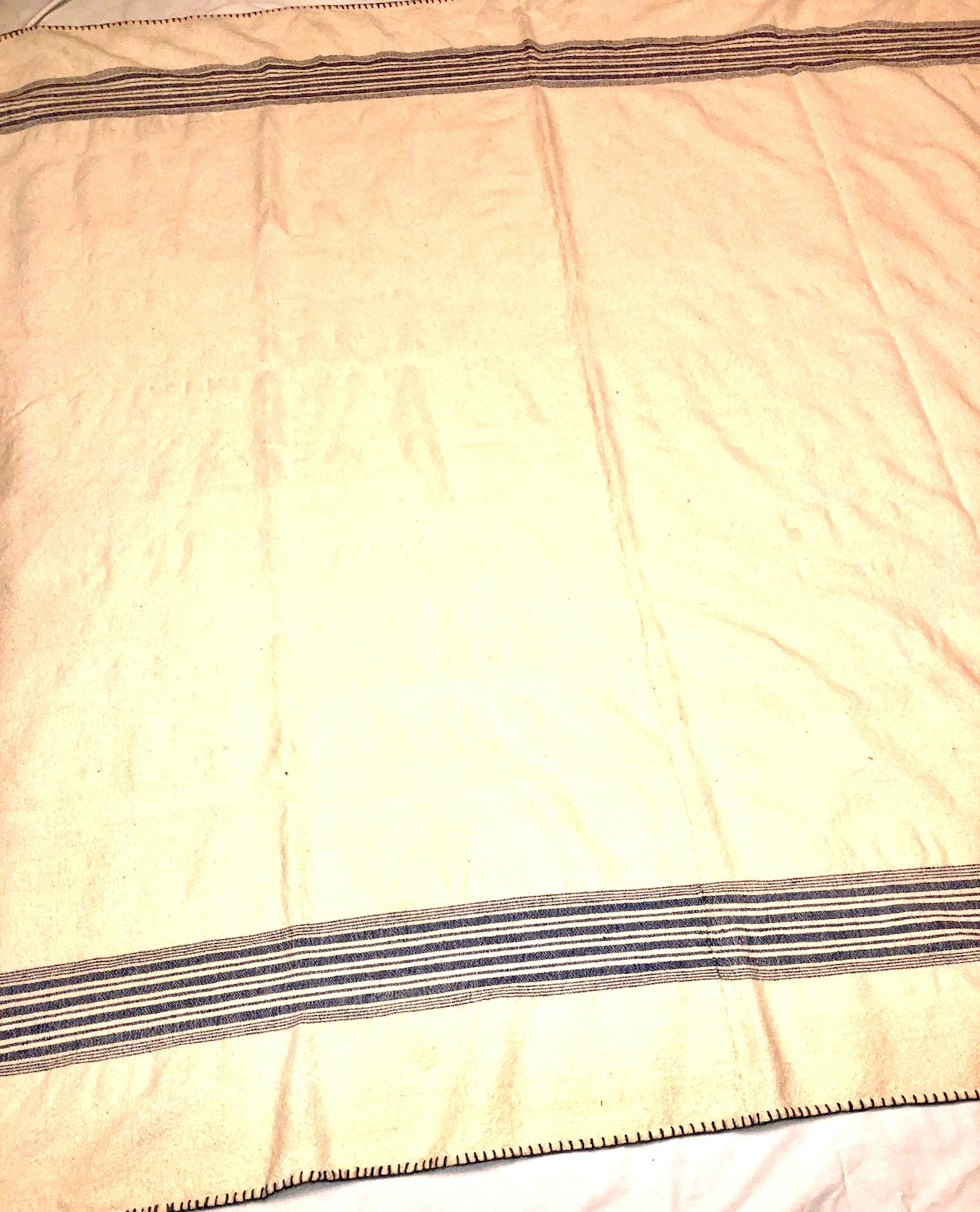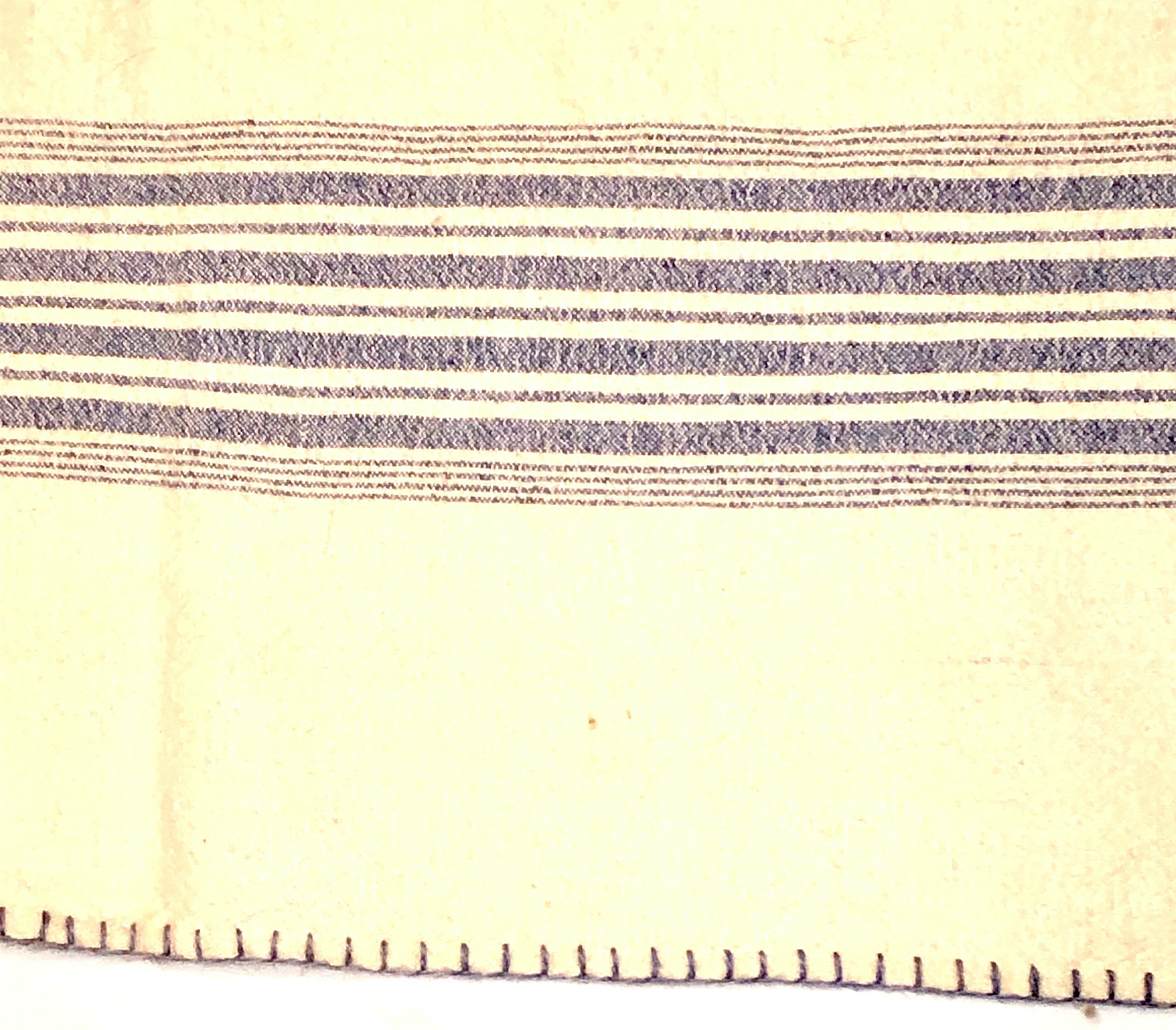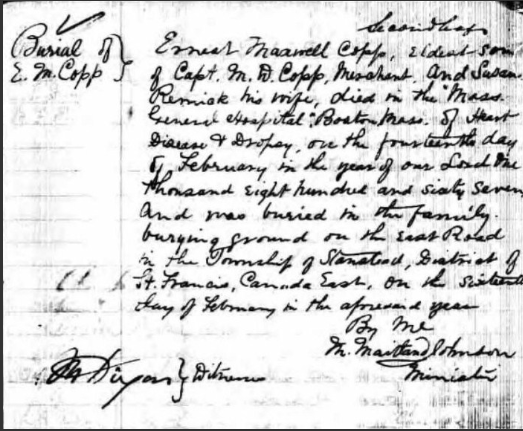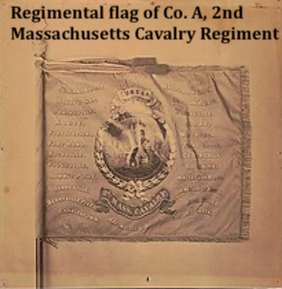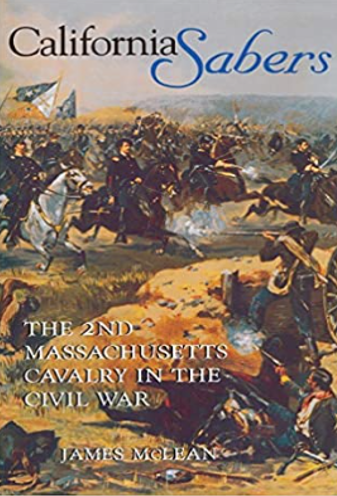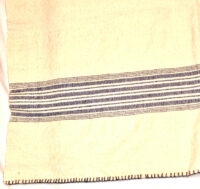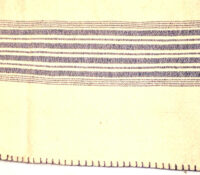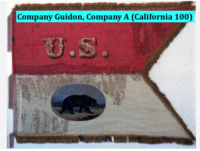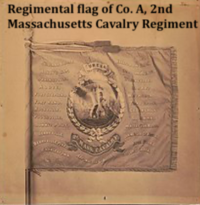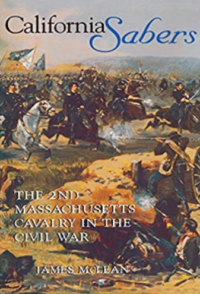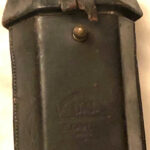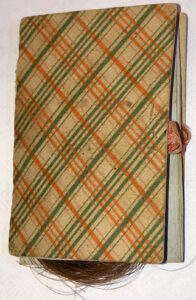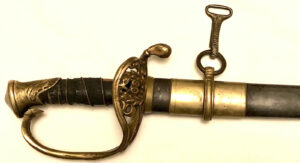Id’d Homespun Mid-Seam Blanket of Private Ernest M. Copp Co. K 2nd Massachusetts Cavalry
$650
Id’d Homespun Mid-Seam Blanket of Private Ernest M. Copp Co. K 2nd Massachusetts Cavalry – This blanket, constructed of homespun, coarse linsey-woolsey (combination of wool and cotton or linen) is an example of a typical, homespun blanket from the first half of the 19th century; loomed at the weaver’s home, these homespun blankets, referred to, in Civil War soldier parlance as “sheeting”, due to their light weight, were constructed of two panels, hand sewn together and therefore referred to as “mid-seam blankets”; home looms, in the 19th century, were not large enough in width to weave panels wider than about 32” or 36”*. Accompanying the blanket is an old, handwritten note that states:
“Linsey-Woolsey
Blanket = 2 piece
Seam middle
Called “Sheeting”
5’ by 6’
Ernest Copp
Boston 23 ?
Co. E, 2nd Reg’t
Ma. Vol. Cav. ?
Jun. 26, ’63. Wounded
Sept. 10, ’64 Berryville
Va. Dis_ June
28, ‘65”
Private Copp was “accidentally” wounded in Berryville, on September 10, 1864. Copp would die shortly after the war, in 1867. The 2nd Massachusetts Cavalry was denoted as the “California Battalion” as several companies in the regiment were composed of volunteers from the state of California who had made the long trek east, to join in the war effort. The 2nd Mass. Cavalry regiment would see action at the Third Battle of Winchester, Fishersville and Cedar Creek.
A series of decorative blue stripes, alternating in width, appear at either end of the blanket; both ends are hand-bound with blue yarn. The blanket remains in superior condition, exhibiting no holes, either insect induced or stress pulls; it appears that it may have been laundered, relatively recently, and is in near useable condition.
Measurements: L – 72”; W – 72”
* Because most looms were narrow, coverlets were often made of two woven panels joined with a center seam. Many geometric coverlets have two seams — three panels joined. That is to say, the weaver had to weave the entire length of the coverlet twice, or three times, and hand sew them together next to each other in order to create a textile that was wide enough to cover the bed! (The National Museum of the American Coverlet)
Ernest Copp
| Residence Boston MA; a 23 year-old Clerk.
Enlisted on 1/5/1863 as a Private. On 1/26/1863 he mustered into “K” Co. MA 2nd Cavalry He was discharged on 6/28/1865 at Philadelphia, PA He was listed as: * Accidentally Wounded 9/10/1864 Berryville, VA |
| Name: | Ernest Copp |
| Enlistment Age: | 23 |
| Birth Date: | abt 1840 |
| Enlistment Date: | 5 Jan 1863 |
| Enlistment Rank: | Private |
| Muster Date: | 26 Jan 1863 |
| Muster Place: | Massachusetts |
| Muster Company: | K |
| Muster Regiment: | 2nd Cavalry |
| Muster Regiment Type: | Cavalry |
| Muster Information: | Enlisted |
| Casualty Date: | 10 Sep 1864 |
| Casualty Place: | Berryville, Virginia |
| Type of Casualty: | Accidentally Wounded |
| Muster Out Date: | 28 Jun 1865 |
| Muster Out Place: | Philadelphia, Pennsylvania |
| Muster Out Information: | disch |
| Side of War: | Union |
| Survived War?: | Yes |
| Residence Place: | Boston, Massachusetts |
| Occupation: | Clerk |
| NAME: | Ernest M Copp |
| DEATH AGE: | 27 |
| RECORD TYPE: | Death |
| BIRTH DATE: | 1840 |
| DEATH DATE: | 14 Feb 1867 |
| DEATH PLACE: | Boston, Massachusetts, USA |
| FATHER: | Moses W |
| MOTHER: | Susan |
| NAME: | Ernest M Copp |
| DEATH AGE: | 27 |
| RECORD TYPE: | Death |
| BIRTH DATE: | 1840 |
| DEATH DATE: | 14 Feb 1867 |
| DEATH PLACE: | Boston, Massachusetts, USA |
| FATHER: | Moses W |
| MOTHER: | Susan |
| Ernest Maxwell Copp
BIRTH 14 Dec 1839 Barnston, Estrie Region, Quebec, Canada DEATH 14 Feb 1867 (aged 27) Boston, Suffolk County, Massachusetts, USA BURIAL Georgeville, Estrie Region, Quebec, Canada
|
2nd MA Cavalry
( 3-years )
| Organized: Readville, MA & State of California on 1/1/63 Mustered Out: 7/20/65 at Fairfax Court House, VA Officers Killed or Mortally Wounded: 8 |
| From | To | Brigade | Division | Corps | Army | Comment |
| May ’63 | Jun ’63 | Unattached | 4 | Department of Virginia | ||
| Jun ’63 | Jul ’63 | 1 | 1 | 4 | Department of Virginia | Cos.A, B, C, D, K |
| Jul ’63 | Aug ’64 | Unattached | King’s | 22 | Department of Washington, D.C. | |
| Aug ’63 | Aug ’64 | Cavalry | 22 | Department of Washington, D.C. | ||
| Aug ’63 | Aug ’64 | 4 | Defenses South of Potomac | 22 | Department of Washington, D.C. | Cos.A, B, C, D, K |
| Aug ’64 | Sep ’64 | 3 | 1 | Cavalry | Army of the Shenandoah | |
| Sep ’64 | Mar ’65 | Reserve | 1 | Cavalry | Army of the Shenandoah | |
| Mar ’65 | Jun ’65 | Reserve | Cavalry | Army of Potomac | Mustered Out |
SECOND REGIMENT MASSACHUSETTS VOLUNTEER CAVALRY
Three Years
| The 2nd Regt. Mass. Vol. Cav. was recruited during the fall of
1862 and the winter following. The first company, “A”, was raised in California by Capt. J. Sewell Reed, and was known as the ” California Hundred “. This company was mustered in at San Francisco, Dec. 10, 1862. It arrived in Boston, Jany. 3, 1863, and was assigned to the quota of Boston. Later four more companies were raised in California by Major Thompson, “E”, “F”, “L”, and “M”, and became known as the “California Battalion”. The remaining companies were raised largely in Boston and other places in the easterly part of Massachusetts, the last company, ” H “, not being mustered in until June 20, 1863. The regiment rendezvoused at Camp Meigs, Readville. Charles Russell Lowell, Jr., who had been a captain in the 6th Regt. U. S. Cavalry, and had served on the staff of Maj. Genl. George B. McClellan from July to November, 1862, was commissioned colonel of the regiment. Companies “A”, “B”, “C”, “D”, and “K” left for Baltimore, Md., Feb. 12, 1863, and proceeded thence to Fort Monroe and from there to Gloucester Point, opposite Yorktown, Va. This battalion under Maj. Caspar Crowninshield was engaged in various raids and expeditions in southeastern Virginia until Aug. 6, when it reported to Colonel Lowell who was at Centreville with the main body of the regiment. The main body of the regiment left Readville, Mass. for the seat of war May 11, proceeding to Washington and camping near that city until July 19, during which period it was engaged in raids and scouting expeditions in the region between Washington and the Blue Ridge. Having been joined by Major Crowninshield’s Battalion, Aug. 6, the career of the regiment as a unit began. At Coyle Tavern near Fairfax Court House, Aug. 24, 1863, in a fight with Mosby’s Battalion the 2d Cavalry lost two killed, two wounded, and several prisoners. About Sept. 15 the 3d Battalion under Major Thompson was transferred to Muddy Brook, Md., where it did picket and patrol duty during the fall and winter. The 1st and 2d Battalions at Centreville were commanded by Major Forbes and Captain Reed, Major Crowninshield commanding the regiment and Colonel Lowell the brigade. These battalions were transferred to Vienna in October and spent the following winter guarding against forays by guerilla bands. The first severe engagement of the regiment was at Dranesville, Feb. 22, 1864, where Captain Reed and about 125 of his men were surprised and defeated, the captain and nine men being killed, seven wounded, and 57 captured. When spring opened several line officers were discharged to accept commissions in the 4th and 5th Regiments of Massachusetts Cavalry. The 2d Regiment was active all through the spring of 1864 doing patrol duty and making raids in the northern part of Virginia. On April 24 its camp was moved to Falls Church. In June a detachment went to the Wilderness battlefield and brought off about fifty wounded men who had been left there. On July 6, Major Forbes, commanding a detachment of about 150 men, was defeated by Mosby’s men in a fight at Mount Zion Church near Aldie, Va., losing eight killed, nine wounded, and 38 prisoners including Major Forbes himself and Chaplain Humphreys. Captain Stone was mortally wounded in this action.
Operating against General Early in July, 1864, during the latter’s raid toward Washington, the 2d Cavalry was engaged at Fort Stevens on July 12, and at Rockville, Md. on the 13th, suffering a loss of six killed and about 100 wounded or captured. The regiment followed with General Wright’s (6th) Corps in pursuit of the enemy until Early’s force had retired across the Shenandoah River, then returned to its camp at Falls Church. Again reporting to General Wright at Rockville, Md., July 26, the regiment was soon after assigned to the 3d Brigade, 1st Division, Cavalry Corps, but about Sept. 9 it was transferred to the Reserve Brigade of the same Division, the Brigade being commanded by Colonel Lowell. For twenty-one consecutive days in the month of August the regiment was under fire. Captain Phillips was wounded on the 22d, Captain Eigenbrodt was killed on the 25th at Halltown near Harper’s Ferry, Lieutenant Meader was killed on the 26th near Charlestown, and during the month the regiment lost six men killed, 28 wounded, and 20 prisoners. In reconnaissances on Opequan Creek between Sept. 7 and 13 it was frequently engaged with loss, on the 13th at Locke’s Ford losing four men mortally wounded and four wounded, not mortally. At Winchester, Sept. 19, its loss was slight. Pursuing the enemy as far as Waynesboro, here on Sept. 28 it had three killed, five wounded, and two captured. It was engaged at Round Top Mountain, Oct. 8, at Tom’s Brook, Oct. 9, and in the battle of Cedar Creek, October 19, losing in the latter action 10 killed, and 22 wounded. Here Colonel Lowell fell mortally wounded, dying the next morning in Middletown. Captain Smith also died of wounds on the evening after the battle. Lieutenant Colonel Crowninshield now became colonel, Major Forbes, lieutenant colonel, and Captain Rumery, major. During the rest of the fall the regiment was active in the lower valley, and the close of the year found it in camp on the Front Royal road a few miles south of Winchester. Late in February, 1865, it left the Valley and proceeded to join the Army of the Potomac before Petersburg. Outpost and scouting duty north and east of Richmond occupied the regiment until the last of March. On March 31, and April 1 the 2d Cavalry was sharply engaged at Dinwiddie Court House and Five Forks, losing on the 31st Lieutenant Munger killed, and Lieutenants Papanti and Thompson wounded. Lieutenant Tucker was wounded April 1. In all on these two days the regiment lost about 20 officers and men in killed, wounded, and missing. These engagements broke the Confederate right, uncovered the Southside Railroad, and insured the fall of Petersburg. Following in pursuit of the enemy, after the evacuation of Petersburg and Richmond, on the 6th of April it participated in the battle of Sailor’s Creek in which Generals Ewell, Kershaw, and Custis Lee were captured and Ewell’s Corps broken up. On the evening of April 8 it assisted in the capture of Lee’s supply trains at Appomattox Station, and on the following morning was with the troops which stopped the further progress of the Army of Northern Virginia at Appomattox Court House. Returning to Petersburg, April 18, six days later it started for North Carolina to operate against Johnston’s army, but, that force surrendering April 26, the 2d Cavalry soon returned to the north side of the Appomattox River. On May 10, it started northward, reaching Washington, D. C., May 21. After the Grand Review, May 23, the regiment went into camp near Cloud’s Mill and later at Fairfax Court House. Here, on the 20th of July, it was mustered out of the United States service. Two days later it started for Massachusetts, returning to its old rendezvous at Camp Meigs, Readville, where, on August 3, 1865, the men were paid off and the regiment disbanded. |
2nd Massachusetts Cavalry Regiment
| 2nd Regiment, Massachusetts Volunteer Cavalry | |
| Company Guidon, Company A (California 100) | |
| Active | December 10, 1862 to July 20, 1865 |
| Country | United States of America |
| Allegiance | Union |
| Branch | United States Army |
| Type | Cavalry |
| Engagements | Third Battle of Winchester Battle of Fisher’s Hill Battle of Cedar Creek |
The 2nd Massachusetts Volunteer Cavalry Regiment was a regiment of cavalry troops in the Union army during the American Civil War. It consisted primarily of men from the states of California and Massachusetts, and served in the Eastern Theater, despite its western roots.
History
Politicians at the start of the Civil War began raising volunteer troops in response to President Abraham Lincoln‘s call to arms to force the return of the Confederate States of America to the Union. Owing to political divisions at the time of the Civil War and to the limited transportation facilities for moving troops great distances, the Lincoln administration did not request California troops for Eastern battlefields but instead called for volunteers to replace regular troops stationed at western garrisons. In the late summer of 1862, a small number of men in California who had been raised in the East decided to enlist in the army, but wanted to serve in the Eastern Theater. They contacted Governor John Andrew of Massachusetts in the late summer of 1862 and offered to raise a company of 100 cavalrymen to serve in a state regiment. Andrews agreed on the condition the Californians would provide their own uniforms and equipment and pay for their own passage to Boston.
The so-called “California Hundred” was organized in San Francisco on December 10, 1862, and took a ship to the East Coast, arriving at Camp Meigs in Readville, Massachusetts, on January 4, 1863.[1] They were designated as Company A, and soon were joined by seven companies of Massachusetts. The Californians and four of the local companies were moved in mid-February to Baltimore, Maryland, then to Fort Monroe and numerous other locations in Virginia, where they primarily engaged in picketing, scouting, and outpost duty until July 1863. Commanded by James Sewall Reed, the Californians first took to the field near Yorktown, Virginia. From July 1863 to July 1864, the California Hundred engaged in numerous skirmishes with John S. Mosby‘s Confederate partisan rangers in the Loudoun Valley.
In February and March 1863, another 400 Californians were recruited and sent to Massachusetts to form Companies E, F, L, and M (the “California Battalion”) of the 2nd Massachusetts Cavalry. They arrived in the Bay State on April 16, 1863, completing the full complement of the regiment. They moved to Washington, D.C., in May and Colonel Charles Russell Lowell was given command.
In August 1863, the regiment was combined in Centreville, Virginia, and became a part of King’s Division in the XXII Corps. They later served in the Army of the Shenandoah under Philip H. Sheridan during the Valley Campaigns of 1864. Among the many actions that the 2nd Massachusetts Cavalry participated in were the battles of Fort Stevens, Opequon, Tom’s Brook, and Cedar Creek. The following spring in 1865, by now under command of Colonel Caspar Crowninshield, it participated in the Siege of Petersburg. In the subsequent Appomattox Campaign it pursued elements of the retreating Army of Northern Virginia, then marched in the Grand Review of the Armies in Washington on May 23. The men were mustered out July 20, 1865, at Fairfax Court House, Virginia, before returning to California and Massachusetts in the weeks that followed.
The regiment lost during its service 8 officers and 82 enlisted men killed and mortally wounded, and 3 officers and 138 enlisted men by disease for a total of 231. Of the original California Hundred’s 3 officers and 101 enlisted men, 40 were present the day the company disbanded. About 12 had died, others were discharged because of sickness or wounds or were transferred to other units, and 10 deserted, a greater desertion rate than from any other Massachusetts regiment.[2]
Two men of the regiment were awarded the Medal of Honor for gallantry in the Valley Campaigns of 1864. The two men were:
- Private Philip Baybuttat Luray, Virginia
- Captain Henry H. Crockerat the Battle of Cedar Creek
Many Patriotic young men on the West Coast had followed the War in the newspapers and were anxious for a chance to join in the fight. But, they knew that if they joined a California State unit, they would be stationed in the West, fighting Indians, guarding commerce trails, or doing garrison duty.
In the late summer of 1862, a group of Californians, all originally from the East Coast, had contacted Governor Andrews of Massachusetts and proposed to raise one hundred volunteers to form a separate company in a cavalry regiment that was being raised in Massachusetts. The Governor agreed with the condition that the Californians would provide their own uniforms and equipment. Officially they became company A of the Second Massachusetts Cavalry, but were more popularly know as the “California Hundred”.
The Californians used their enlistment bounty to pay for their passage and set off aboard the Golden Age by sea from San Francisco, December 1, 1862. At the Isthmus of Panama they debarked, transited the Isthmus by rail, then boarded the Ocean Queen for the eastern seaboard. The men arrived at Camp Meigs, Readville, Mass. on January 4, 1863. After spending several weeks of basic training at Camp Meigs, the Company was transported to Fortress Monroe, Va. and placed on active duty at Gloucester Point on February 22, 1863.
This first contingent was so appreciated that it was followed by 400 more California volunteers. They arrived at Camp Meigs during March and April of 1863 and soon after receiving their basic training joined Company A and the rest of the 2nd Mass. Cavalry as Companies E, F, L, and M. This second group of Californians were known as the “California Battalion”.
California Sabers is the story of the California Battalion and Hundred, a group of 500 select men who were the only organized group of Californians to fight in the East during the Civil War. They volunteered their enlistment bounty to pay their passage across Panama and on to
Massachusetts, where they became the cadre of the Second Massachusetts Cavalry.
From mid-1863 to July 1864, the Second Massachusetts fought a bloody guerilla war in northern Virginia against John S. Mosby, the confederacy’s “Gray Ghost.” In July 1864 the regiment became part of Sheridan’s Army of the Shenandoah, and that fall it played a major role in the decisive battles of Winchester, Toms Run, and Cedar Creek.
In early 1865 the regiment was in the column that marched across Virginia destroying the vital railroad and canal that carried supplies from the Shenandoah Valley to the besieged Army of Northern Virginia. In late March, the Second Massachusetts was in the forefront of the battles at Dinwiddie Courthouse and Five Forks, the two actions that finally broke the stalemate at Petersburg and forced Lee to retreat to the west. In the ensuing chase, the regiment was the part of the cavalry spearhead that finally blocked Lee’s army at Appomattox Courthouse.




